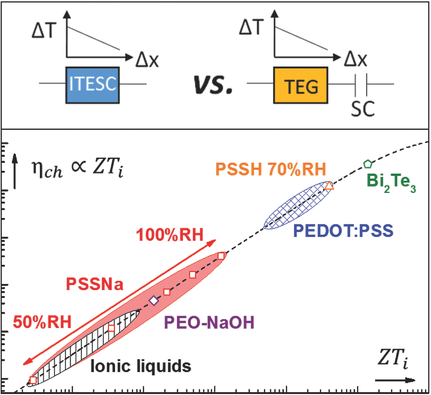当前位置:
X-MOL 学术
›
Adv. Electron. Mater.
›
论文详情
Our official English website, www.x-mol.net, welcomes your
feedback! (Note: you will need to create a separate account there.)
Ionic Thermoelectric Figure of Merit for Charging of Supercapacitors
Advanced Electronic Materials ( IF 5.3 ) Pub Date : 2017-03-10 , DOI: 10.1002/aelm.201700013
Hui Wang 1 , Dan Zhao 1 , Zia Ulla Khan 1 , Skomantas Puzinas 1 , Magnus P. Jonsson 1 , Magnus Berggren 1 , Xavier Crispin 1
Advanced Electronic Materials ( IF 5.3 ) Pub Date : 2017-03-10 , DOI: 10.1002/aelm.201700013
Hui Wang 1 , Dan Zhao 1 , Zia Ulla Khan 1 , Skomantas Puzinas 1 , Magnus P. Jonsson 1 , Magnus Berggren 1 , Xavier Crispin 1
Affiliation

|
Thermoelectric materials enable conversion of heat to electrical energy. The performance of electronic thermoelectric materials is typically evaluated using a figure of merit ZT = σα2T/λ, where σ is the conductivity, α is the so‐called Seebeck coefficient, and λ is the thermal conductivity. However, it has been unclear how to best evaluate the performance of ionic thermoelectric materials, like ionic solids and electrolytes. These systems cannot be directly used in a traditional thermoelectric generator, because they are based on ions that cannot pass the interface between the thermoelectric material and external metal electrodes. Instead, energy can be harvested from the ionic thermoelectric effect by charging a supercapacitor. In this study, the authors investigate the ionic thermoelectric properties at varied relative humidity for the polyelectrolyte polystyrene sulfonate sodium and correlate these properties with the charging efficiency when used in an ionic thermoelectric supercapacitor (ITESC). In analogy with electronic thermoelectric generators, the results show that the charging efficiency of the ITESC can be quantitatively related to the figure of merit ZTi = σiαi2T/λ. This means that the performance of ionic thermoelectric materials can also be compared and predicted based on the ZT, which will be highly valuable in the design of high‐performance ITESCs.
中文翻译:

离子热电超级电容器充电的优点
热电材料能够将热量转换为电能。的电子热电材料的性能,使用品质因数通常评价ZT = σα 2 Ť/λ,其中σ是电导率,α是所谓的塞贝克系数,而λ是热导率。然而,目前尚不清楚如何最好地评估离子热电材料(如离子固体和电解质)的性能。这些系统不能直接在传统的热电发生器中使用,因为它们基于无法通过热电材料和外部金属电极之间的界面的离子。相反,可以通过给超级电容器充电从离子热电效应中收集能量。在这项研究中,作者研究了聚电解质聚苯乙烯磺酸钠在不同相对湿度下的离子热电性质,并将这些性质与离子热电超级电容器(ITESC)中的充电效率相关联。ZT我= σiαi 2 Ť /λ。这意味着还可以基于ZT来比较和预测离子热电材料的性能,这在高性能ITESC的设计中将具有很高的价值。
更新日期:2017-03-10
中文翻译:

离子热电超级电容器充电的优点
热电材料能够将热量转换为电能。的电子热电材料的性能,使用品质因数通常评价ZT = σα 2 Ť/λ,其中σ是电导率,α是所谓的塞贝克系数,而λ是热导率。然而,目前尚不清楚如何最好地评估离子热电材料(如离子固体和电解质)的性能。这些系统不能直接在传统的热电发生器中使用,因为它们基于无法通过热电材料和外部金属电极之间的界面的离子。相反,可以通过给超级电容器充电从离子热电效应中收集能量。在这项研究中,作者研究了聚电解质聚苯乙烯磺酸钠在不同相对湿度下的离子热电性质,并将这些性质与离子热电超级电容器(ITESC)中的充电效率相关联。ZT我= σiαi 2 Ť /λ。这意味着还可以基于ZT来比较和预测离子热电材料的性能,这在高性能ITESC的设计中将具有很高的价值。






































 京公网安备 11010802027423号
京公网安备 11010802027423号